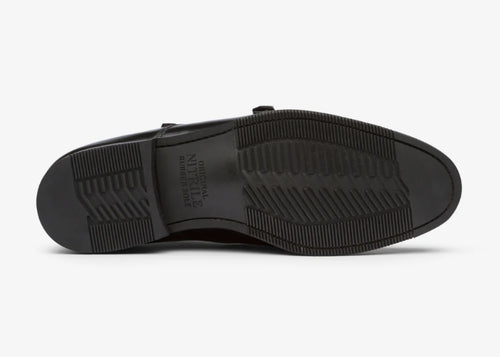Materials
Upper Leathers
Outsoles
Other Materials

Box calf full grain
Usually 1.2 - 1.4 mm thickness, it is the best kind of leather for formal mens shoes where the original grain is kept intact. The tight, compact grain structure gives a nice shine when polished and gives a fine look to the shoe. It will be stiffer than most leathers to start with, but will soften up nicely over time.
It is this inner rigidity that is inherent to this leather type that makes it ideal for formal shoes. It also lends well to the shape of the last and makes the shoe look sharp even after many wears and kept in shoe trees. Anilinity gives the leather depth and richness especially as it ages and has layers of creams and waxes giving it a rich natural patina over time. Our box calf leathers come from the tanneries of Annonay, du Puy and Weinheimer.

Naturally milled
The leather is much softer and ‘dyed through and through’ where the fat liquors penetrate the pores, fully making it inherently soft. But by using fuller substance, 1.8 - 2.0 mm thickness it helps in holding shape and giving a nice cushion-like effect to the wearer.
The full skin will have a variable grain pattern where some parts might have a bold pattern and some a finer milling pattern. We work on a spectrum where no milling and very large milling patterns are avoided in the cutting of the leather. Small, medium and large milling patterns are cut pair by pair so there isn’t any variation between the left and right. The leather is tumbled in a dry drum which helps give it a soft pleasing texture. These leathers are locally made in an LWG certified leather using European raw hides.

Textured
A heated printing plate is pressed on top of the leather giving it a distinct look and feel. A tad bit on the stiffer, this leather type is best suited for a more casual look, especially the pebble grain and the hatch grain. The pin needle grain and Russian reindeer calf replica are increasingly being used in more formal styles, making printed leathers more acceptable in such settings. The Russian reindeer calf is only made at the English tannery of J & F.J. Baker, while others are locally printed from full grain leathers from our stocks. The pin needle was specially developed in collaboration with a Sri Lankan tannery.

Nubuck
This leather is closer to a full grain, where the tight top part of the skin is kept more or less intact and sanded down minimally, just enough to give it the soft velvet touch and feel.Used mostly for more casual styles, they get a lot of undue publicity for difficulty in maintenance. With a water proof spray on top, shoes from this leather type can actually be very easy to maintain as they don’t need any cream or wax like full grain leathers do. Our nubucks, like our naturally milled leathers, are of fuller substance of 1.8 - 2.0 mm thickness which help in shape retention and give a good, soft touch to the feet. These leathers are locally made in an LWG certified leather using European raw hides.

Suede calf skin
Where the hide is split in two parts, the bottom fleshy part is used to make suede, and the top part is used to make another product. Good suede will have a nice short nap, which means it will feel soft and velvety giving it a rich allure. Suedes are misunderstood as ‘not easy to maintain’ which couldn’t be further from the truth. A water-proof spray will ensure they are great even on a rainy day, and all you need is a suede brush to give it a nice sheen and remove surface level dust. Occasionally it can be cleaned with light soap water, so in many ways it's actually easier to maintain, than full grain box calf, which requires creams and waxes to keep the leather healthy.

Reverse suede
Where the top grain is only slightly sanded down similar to nubuck, so it retains the strength of the hide but the reverse side(the flesh side) is treated to give it a nice short nap. This is rarely made by many tanneries, owing to difficulty in treating two sides of the same skin and achieving a matching colour on both. We use only the best from the tannery of Charles F. Stead in England, who pioneered this leather type and now increasingly used for unlined construction, where both sides can be appreciated.
Drum dyed crust

Used in the lining of the shoe, where sweat absorption is important. Most linings are only upto 1 mm thick, rarely higher. However, we use 1.4 - 1.6 mm thick lining leathers, since we don’t use interlining materials and minimal adhesives between the upper and the lining. The thick lining further helps to hold the shape of the last, especially over time. The leather is dyed in the drum in the tanning process, as the name suggests, so no finishing dye solutions are sprayed on it, which may reduce its absorptive capacity. Lining leather can come in direct contact with your skin, so it's important that it is well ‘fixed’ making sure colours don’t bleed. All our lining leathers are made in local micro tanneries that are LWG certified.



























